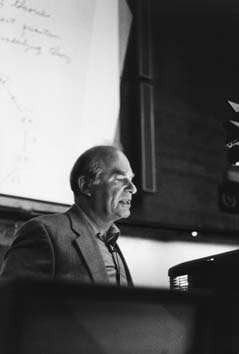Personal tools
News from ICTP 95 - Commentary

The study of string theory has helped to advance the frontiers of mathematics and theoretical physics. One of its most distinguished proponents examines the 'unifying' road ahead.
Strings Strung

John Schwarz
We think of particle physics
addressing the microscopic extreme and cosmology addressing the
macroscopic extreme. However, string theory, through its explorations
of the behaviour of gravity in both scales, allows us to consider
particle physics and cosmology together. In fact, string theory
offers deep connections between the two.
Proponents of string theory have contended that the theory requires
extra spatial dimensions, which have generally been assumed to
form a compact space of six or seven dimensions. Recent investigations,
however, suggest that the extra dimensions in which the strings
exist could be much larger than previously envisioned--perhaps
large enough to be experimentally observable.
I find the idea of large extra dimensions to be implausible because
it sacrifices some of the successes of supersymmetric grand unification,
such as the unification of the couplings and suppression of proton
decay. Nevertheless, I agree that it is worthwhile to explore
these ideas. Who knows what might turn up?
I do not expect string theory to be completely understood by pure
thought alone. The more traditional back and forth between theory
and experiment surely will be important in this quest. The most
immediate experimental question is whether supersymmetry particles
will be discovered this decade. Such a discovery would have profound
theoretical and experimental consequences, helping to set the
agenda for experimental particle physics for several decades to
come.
The discovery of supersymmetry would make it clear that the abstract
mathematical musings of the past 30 years can be connected to
experimental science. Experimental findings about supersymmetry
at the electroweak scale, in turn, would provide crucial guidance
in the quest to understand how to connect the underlying theory
to the real world.
Through the study of string theory, the last third of the 20th
century witnessed the construction of an amazing mathematical
edifice that we are still struggling to understand. I am convinced
that the theory is unique, and I am optimistic that a deeper formulation
will be found. The theory could well lay the intellectual foundation
for uncovering solutions accounting for the observations both
of particle physics and cosmology.
The subject of string theory has involved a host of new and bizarre
concepts, much as quantum mechanics did in the first half of the
20th century. To get it right we will need help from both our
mathematical and experimental friends. But that should come as
no surprise. In fact, it is only fitting that a theory that seeks
to unify particles and forces at extreme micro- and macro-scales
may wind up unifying disciplines as well.
John Schwarz
ICTP Dirac Medallist
California Institute of Technology, Pasadena, California, USA